Television & Shows
Dealing with those last-episode-of-the-season “Doctor Who” blues? BritBox and its amazing collection of British TV shows can help
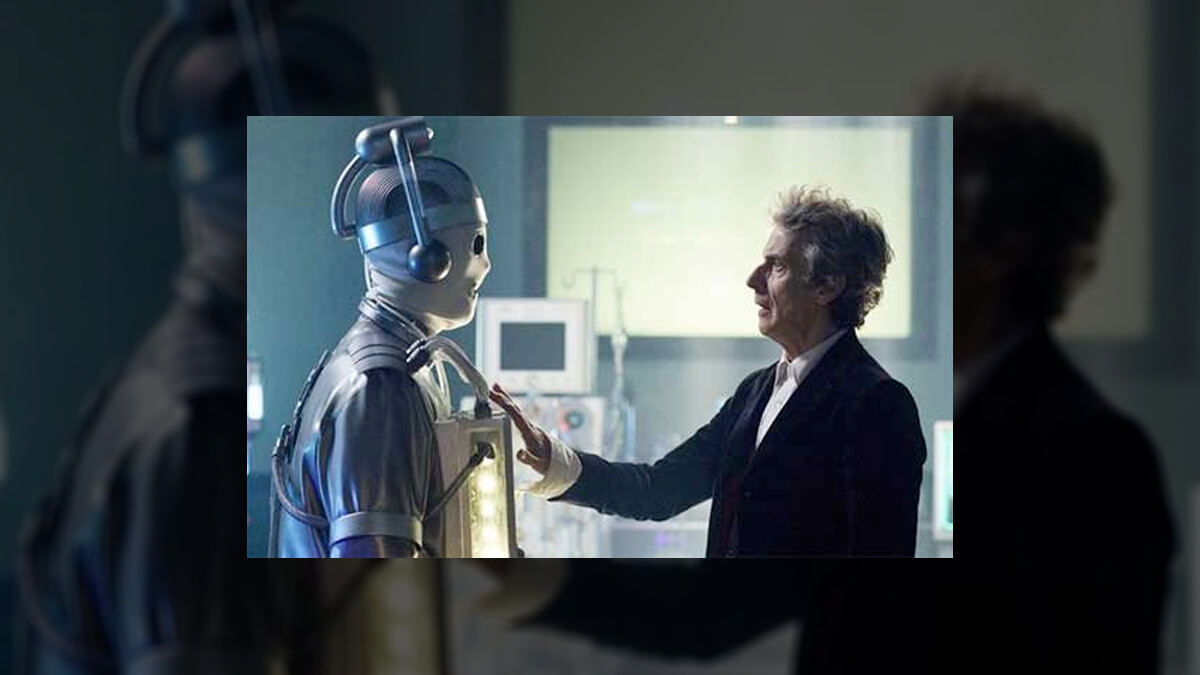
There are TV programs where you can watch any one randomly-selected episode and then immediately know everything that you need to know about that particular set of characters & the world that they live in. And then there are shows like “Doctor Who.”
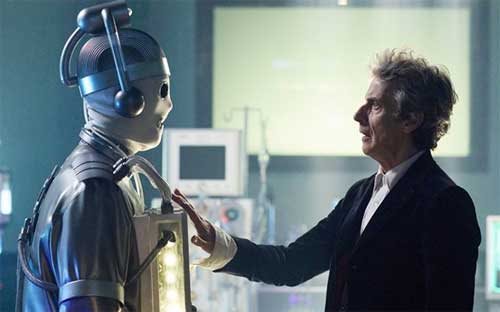 Copyright BBC. All rights reserved
Copyright BBC. All rights reserved
I bring this up because … This past weekend, BBC America aired “World Enough and Time,” the first part of “Doctor Who” ‘s Season 10 finale. And I have to admit that I kind of felt sorry for any first-time viewer of this much-beloved British sci-fi show who then chose this particular episode to be their entry point for this long-running series. Because there were so many elements of “World Enough and Time” (EX: That moment when Missy realized the 400 mile-long spaceship she was traveling on had originally come from Mondas. Or when Razor removed his mask) that only made sense / had any real impact if you’d previously watched episodes of this program.
And – no – I’m not talking about circling back on some of the “Doctor Whos” that Christopher Eccleston, David Tennant, Matt Smith & Peter Capaldi have done since BBC One first revived this show back in 2005. If you want to truly appreciate the Doctor’s convoluted relationship with the Master (or – for that matter – understand why so many British television viewers are flat-out terrified of the Cybermen), then you probably need to head over to BritBox and start VODing your way through a number of the Classic “Doctor Who” episodes that are archived there.
Because the Mondasian Cybermen … Well, they were actually introduced back in October of 1966 during the fourth season of Classic “Doctor Who.” To be specific, the episode where this race of cybernetically augmented humanoids first came on the scene was called “The Tenth Planet.” And most Whovians have a soft spot for this particular episode. Largely because “The Tenth Planet” was the show on which William Hartnell made his last regular appearance as the First Doctor. Not to mention being the episode when Patrick Troughton made his debut as the Second Doctor.
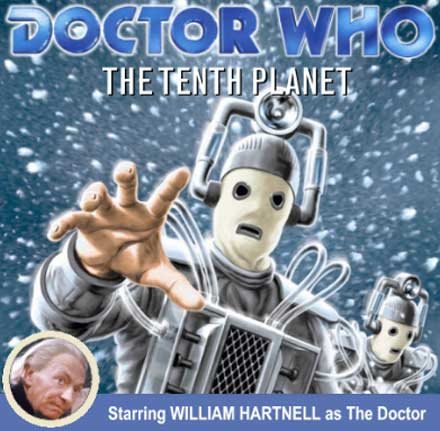 Copyright BBC. All rights reserved
Copyright BBC. All rights reserved
On the other hand, BritBox … It made its debut back in March of this year. This new subscription video on demand (SVOD) streaming service came about because BBC Worldwide (i.e., the commercial arm of the BBC) & ITV (i.e., the UK’s biggest commercial broadcaster) decided to join forces. So that two broadcasting giants could then create the most comprehensive collection of British television, across all genres, available anywhere in the U.S.
And who did BBC Worldwide & ITV select to be in charge of this ambitious joint venture? Soumya Sriraman, an entertainment industry vet with more than two decades of experience in the field. Most recently, Soumya was the executive vice president in charge of franchise and digital enterprises at BBC Worldwide North America. Which – of course – made her the perfect choice to run this new SVOD streaming service based in the U.S.
And just so you know: Ms. Sriraman also has strong ties to the world of “Doctor Who.” She was the one who helped heightened the sense of excitement that came as each new season of BBC One’s “Who” reboot premiered by periodically arranging to have individual episodes of the show screened in cinemas in North America.
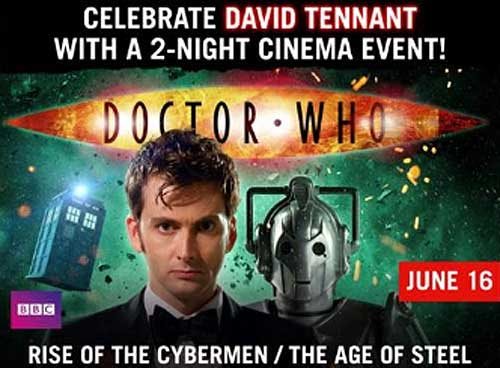 Copyright BBC / Fathom. All rights reserved
Copyright BBC / Fathom. All rights reserved
But what’s Souyma’s plan for BritBox? To put it simply, her goal was to create a place for people who are passionate about British television.
“This is for all those Anglophiles out there. Previously, these people – if they wanted to get their ‘As Time Goes By’ or ‘Inspector Morse’ fix – often had to take a piecemeal approach. Which meant that they had to try and catch those classic shows whenever they’d air on their local PBS stations,” Sriraman explained during a recent phone interview. “But now with BritBox, you’ll now be able to find all of the episodes from many of your favorite British television shows all in one place. That was our ultimate goal here: To create the biggest streaming collection of British TV. One that managed to touch on all genres: dramas, comedies, mysteries, the works.”
And the best part is … The people who work to curate BritBox are just as passionate about these programs as the viewers are. You only have to look at this SVOD streaming service’s Classic Doctor Who section to see all of the care & the thought that’s gone into the curation of this amazing collection of TV shows.
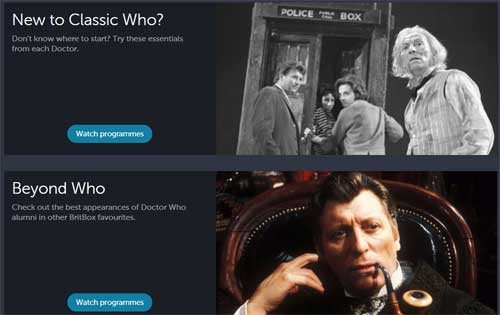 Copyright BritBox. All rights reserved
Copyright BritBox. All rights reserved
Have you been a fan of this British sci-fi show since it first debuted back in November of 1963? Well, then maybe you’d enjoy checking out BritBox’s list of top ten monsters & aliens that they like to see be resurrected as villains on the new “Doctor Who.” On the other hand, if you’re new to Classic Doctor yourself and would like a better grounding in this program’s history & characters … Well, there’s literally a page for that. BritBox staffers have suggestion when it comes to essential episodes to view if you want to get up-to-speed on those first seven Doctors.
The reason that I’m bringing up BritBox today is that … Well, the last official episode of “Doctor Who” Season 10 airs tonight on BBC America. And once “The Doctor Falls” is over, it’ll be six months ’til the Christmas Special airs. And that’s a very long time to wait to A) find out why exactly Peter Capaldi’s Doctor needs to regenerate and B) discover who the next Doctor Who is going to be.
So – to help fill up those 180 days – you might want to check out some of the classic Doctor Who episodes that are archived at BritBox. Or better yet, stream some “Blackadder” or “Fawlty Towers.” Given how grim things got on “World Enough and Time” last week, I’m thinking that we’re all going to need a few laughs once “The Doctor Falls” is over later tonight.
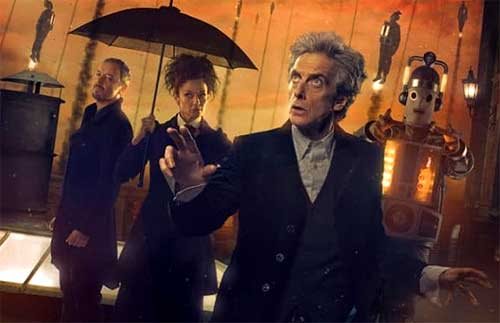 Copyright BBC. All rights reserved
Copyright BBC. All rights reserved
This article was originally published by the Huffington Post on Saturday, July 1, 2017
Film & Movies
“Indiana Jones and the Search for Indiana Jones”
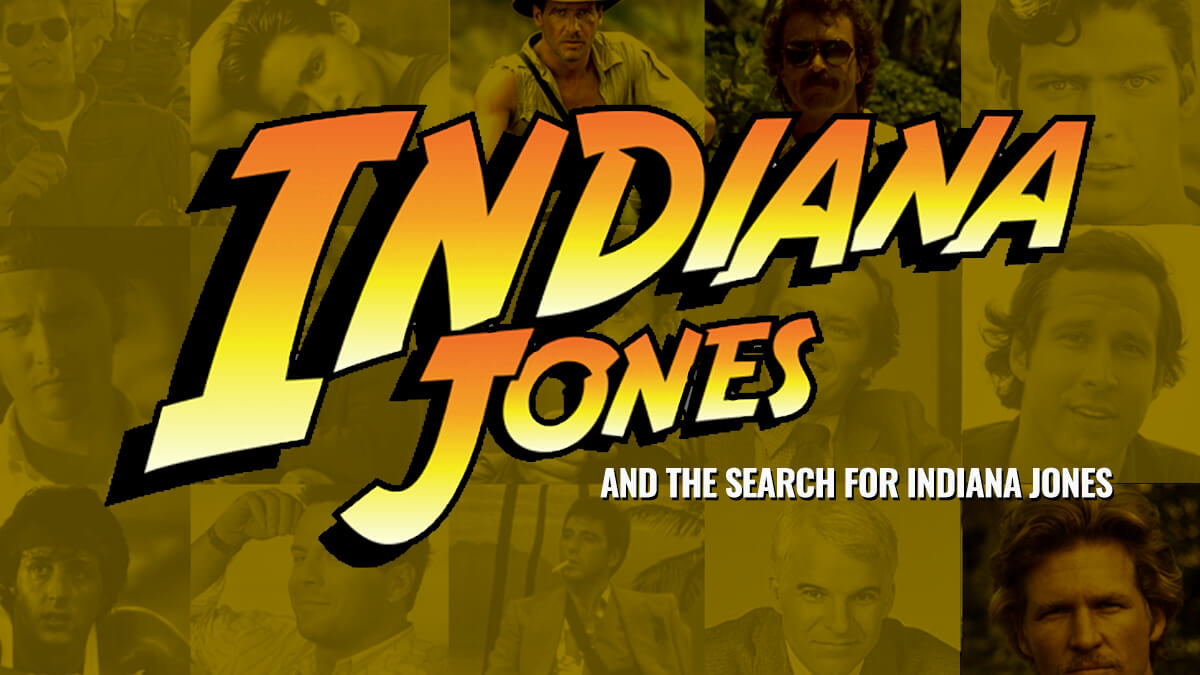
News came late last week that NBC was cancelling the “Magnum PI” remake. This series (which obviously took its inspiration from the Tom Selleck show that originally debuted on CBS back in December of 1980 and then went on run on that network for 8 seasons. With its final episode airing on May 8, 1988).
Anyway … Over 30 years later, CBS decided to remake “Magnum.” This version of the action drama debuted on September 24, 2018 and ran for four seasons before then being cancelled. NBC picked up the “Magnum” remake where it ran for one more season before word came down on June 23rd that this action drama was being cancelled yet again.
FYI: The second half of Season 5 of “Magnum” (10 episodes) has yet to air on NBC. It will be interesting to see when that final set of shows / the series finale gets scheduled.
This all comes to mind this week – out ahead of the theatrical release of “Indiana Jones and the Dial of Destiny” because … Well, if CBS execs had been a bit more flexible back in 1980, the star of the original version of “Magnum PI” (Tom Selleck) would have played the lead in “Raiders of the Lost Ark.” Which was released to theaters back on June 12, 1981.
That’s the part of the Indiana Jones story that the folks at Lucasfilm often opt to skim over.
That Harrison Ford wasn’t George Lucas’ first choice to play Doctor Jones.
Auditions for Indiana Jones – Harrison’s Not on the List
Mind you, Steven Spielberg – right from the get-go – had pushed for Ford to play this part. The way I hear it, Lucas showed Spielberg a work-in-progress cut of “The Empire Strikes Back.” And Steven was so taken with Harrison’s performance as Han Solo in that Irwin Kershner film that he immediately began pushing for Ford to be cast as Doctor Jones.
Whereas Mr. Lucas … I mean, it wasn’t that George had anything against Harrison. What with Ford’s performances first in “American Grafitti” and then in “A New Hope,” these two already had a comfortable working relationship.
But that said, Lucas was genuinely leery of … Well, the sort of creative collaboration that Martin Scorcese and Robert DeNiro. Where one actor & one director repeatedly worked together. To George’s way of thinking, that was a risky path to follow. Hitching your wagon to a single star.
Which is why – when auditions got underway for “Raiders of the Lost Ark” in 1979 — Mike Fenton basically brought in every big performer of that era to read for Dr. Jones except Harrison Ford. We’re talking:
- Steve Martin
- Chevy Chase
- Bill Murray
- Jack Nicholson
- Peter Coyote
- Nick Nolte
- Sam Elliot
- Tim Matheson
- and Harry Hamlin
Casting a Comedian for Indiana Jones
Please note that there are a lot of comedians on this list. That’s because – while “Raiders of the Lost Ark” was in development — Spielberg was directed his epic WWII comedy, “1941.” And for a while there, Steve & George were genuinely uncertain about whether the movie that they were about to make would be a sincere valentine to the movie serials of the 1930s & the 1940s or more of a spoof.
It’s worth noting here that three of the more ridiculous set pieces found in “Temple of Doom” …
- the shoot-out at Club Obi Wan in Shanghai
- Indy, Willie & Short Round surviving that plane crash by throwing an inflatable life raft out of the cargo hatch
- and that film’s mine cart chase (which was not only inspired by Disney theme park favorites the Matterhorn Bobsleds & Big Thunder Mountain Railroad but some of the sound effects that you hear in this portion of “Temple of Doom” were actually recorded after hours at Disneyland inside of these very same attractions)
… all originally supposed to be in “Raiders of the Lost Ark.” I’ve actually got a copy of the very first version of the screenplay that Lawrence Kasdan wrote for the first “Indy” movie where all three of these big action set pieces were supposed to be part of the story that “Raiders” told. And I have to tell you that this early iteration of the “Raiders” screenplay really does read more like a spoof of serials than a sincere, loving salute to this specific style of cinema.
Casting Indiana Jones – Jeff or Tom
Anyway … Back now to the casting of the male lead for “Raiders” … After seeing virtually every actor out in LA while looking for just the right performer to portray Indiana Jones, it all came down to two guys:
- Jeff Bridges
- and Tom Selleck
Jeff Bridges as Indiana Jones
Mike Fenton was heavily pushing for Jeff Bridges. Having already appeared with Clint Eastwood in 1974’s “Thunderbolt & Lightfoot” (Not to mention that “King Kong” remake from 1976), Bridges was a known quantity. But what Fenton liked especially liked about Bridges when it came to “Raiders” was … Well, at that time, Jeff was just coming off “Heaven’s Gate.”
Mind you, nowadays, because we’ve all now had the luxury of seeing the director’s cut of this Michael Cimino movie, we recognize “Heaven’s Gate” for the cinematic masterpiece that it is. But 40+ years ago, that honestly wasn’t the case. All audiences had to judge this movie by was the severely truncated version that United Artists sent out into theaters. Which – because “Heaven’s Gate” had cost $44 million to make and only sold $3.5 million of tickets – then became the textbook example of Hollywood excess.
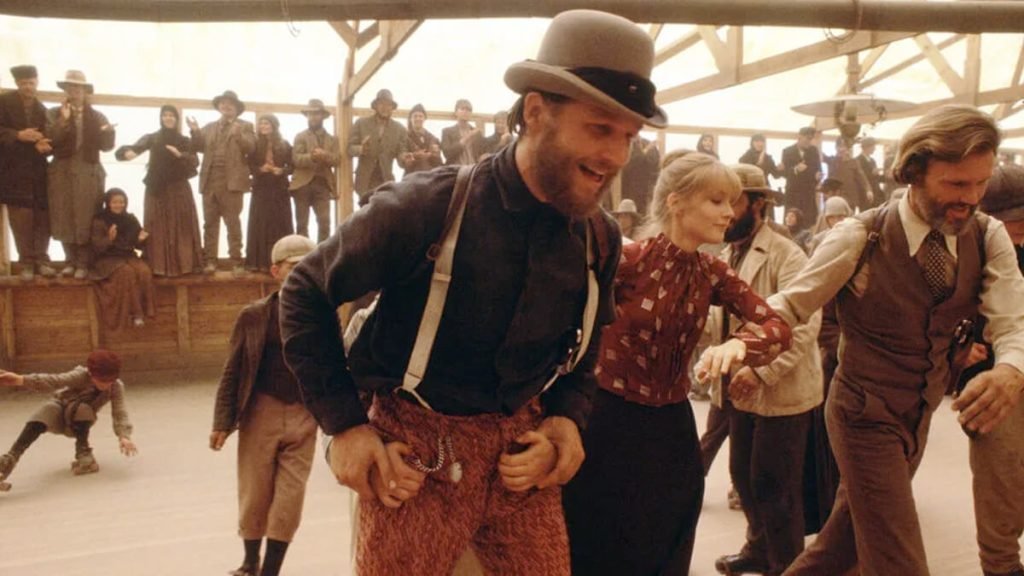
Long story short: Given that being associated with “Heaven’s Gate” had somewhat dinged Bridges’ reputation for being a marketable star (i.e., a performer that people would pay good money to see up on the big screen), Jeff was now looking to appear in something highly commercial. And the idea of playing the lead in a film directed by Steven Spielberg (the “Jaws” & “Close Encounter” guy) and produced by George Lucas (Mr. “Star Wars”) was very, very appealing at that time. Bridges was even willing to sign a contract with Spielberg & Lucas that would have then roped him into not only playing Indiana Jones in “Raider of the Lost Ark” but also to appear as this very same character in two yet-to-be-written sequels.
Better yet, because “Heaven’s Gate” had temporarily dimmed Bridges’ star status, Jeff was also willing to sign on to do the first “Indy” film for well below his usual quote. With the understanding that – should “Raiders of the Lost Ark” succeed at the box office – Bridges would then be paid far more to appear in this film’s two sequels.
That seemed like a very solid plan for “Raiders.” Landing a known movie star to play the lead in this action-adventure at a bargain price.
Ah, but standing in Mike Fenton’s way was Marcia Lucas.
Tom Selleck as Indiana Jones
Marcia Lucas, who had seen Tom Selleck’s audition for “Raiders” (And you can see it as well. Just go to Google and type in “Tom Selleck” and “Indiana Jones.” And if you dig around for a bit, you’ll then see a feature that Lucas & Spielberg shot for “Entertainment Tonight” back in 2008 [This story was done in support of the theatrical release of “Indiana Jones and the Kingdom of the Crystal Skull”]. And as part of this piece, George and Steve share Tom’s original audition for “Raiders.” And what’s genuinely fascinating about this footage is that Selleck’s scene partner is Sean Young. Who – at that time, anyway – was up for the role of Marion Ravenwood) and kept telling her husband, “You should cast this guy. He’s going to be a big star someday.”
And given that George was smart enough to regularly heed Marcia Lucas’ advice (She had made invaluable suggestions when it came to the editing of “American Graffiti” and the original “Star Wars.” Not to downplay George Lucas’ cinematic legacy, but Marcia Lucas was a world-class storyteller in and of her own right), Lucas then reached out to Spielberg and persuaded him that they should cast relative unknown Tom Selleck as Doctor Jones over the already well-known Jeff Bridges.
Now don’t feel too bad for Jeff Bridges. When he lost out on playing the lead in “Raiders of the Lost Ark,” Jeff then accepted a role in the very next, high profile, sure-to-be-commercial project that came along. Which turned out to be Disney’s very first “TRON” movie. Which was eventually released to theaters on July 9, 1982.
Back to Tom Selleck now … You have to remember that – back then – Selleck was the handsome guy who’d already shot pilots for six different shows that then hadn’t gone to series. Which was why Tom was stuck being the guest star on shows like “The Fall Guy” and “Taxi.” Whereas once word got out around town that Selleck was supposed to play the lead in a project that Spielberg was directed & Lucas was producing … Well, this is when CBS decided that they’d now take the most recent pilot that Tom had shot and then go to series with this show.
That program was – of course – the original “Magnum PI.” And it’s at this point where our story started to get complicated.
“Magnum PI” – Two Out of Three Say “Yes”
Okay. During the first season of a TV show, it’s traditionally the network – rather than the production company (which – in this case – was Glen A. Larson Productions. The company behind the original versions of “Battlestar Galactica” & “Knight Rider”) or the studio where this series is actually being shot (which – in this case – was Universal Television) that has all the power. And in this particular case, the network execs who were pulling all the strings behind-the-scenes worked for CBS.
And when it came to the first season of “Magnum PI,” CBS had a deal with Glen A. Larson Productions and Universal Television which stated that the talent which had been contracted to appear in this new action drama would then be available for the production of at least 13 episodes with an option to shoot an additional 9 episodes (This is known in the industry as the back nine. As in: the last nine holes of a golf course).
Anyway, if you take those initial 13 episodes and then tack on the back nine, you then get 22 episodes total. Which – back in the late 1970s / early 1980s, anyway – was what a full season of a network television show typically consisted of.
Anyway … The contract that Selleck had signed with Glen A. Larson Productions, Universal Television & CBS stated that he had to be available when production of Season One of “Magnum PI” began in March of 1980. More to the point, Tom also had to be available should CBS exercise its option to air 22 episodes of this new series on that television network over the course of “Magnum PI” ‘s first season.
Which then made things complicated for George Lucas & Steven Spielberg because … Well, in order for “Raiders of the Lost Ark” to make its June 12, 1981 release date, that then meant that production of the first “Indy” movie would have to get underway no later than June 23, 1980.
But here’s the thing: Production of Season One of “Magnum PI” was scheduled to run through the first week of July of that same year (1980). So in order for Tom Selleck to play Indiana Jones in “Raiders,” he was going to need to be wrapped on production of “Magnum PI” by June 22, 1980 at the absolute latest.
So Spielberg & Lucas went to Glen A. Larsons Productions and asked if Selleck could please be sprung from his “Magnum PI” contractual obligations by June 22nd. And they said “Yes.” Then Steven & George went to Universal Television and asked executives there for their help in clearing Tom’s schedule so that he’d then be available to start work on “Raiders.” And they say “Yes” as well.
Spielberg & Lucas now go to CBS. But instead of the quick “Yeses” that they got from officials at Glen A. Larson Productions and Universal Television, it takes those suits at the Tiffany Network weeks before they then decided to say “No, they couldn’t release Tom Selleck early to go work on ‘Raiders’ “ because …
I’ve never really been able to get a straight answer here as to why CBS execs dug in their heels here. Why they flat-out refused to release Selleck early from his “Magnum PI” contractual obligation and allow him to go shoot “Raiders.”
Payback from “The Star Wars Holiday Special” Trash Talk
That said, it is worth noting that “The Star Wars Holiday Special” aired on CBS back in November of 1978. And given that – in the years that followed — Lucas wasn’t exactly shy when it came to saying how much he hated that two hour-long presentation (Or – for that matter – how George really regretted caving into the requests of CBS execs. Who had insisted that television stars long associated with the Tiffany Network – people like Art Carney, Harvey Korman & Bea Arthur – be given prominent guest starring roles in “The Star Wars Holiday Special”). And I’ve heard whispers over the years that CBS executives preventing Tom Selleck from appearing in “Raiders” could be interpreted as the Tiffany Network getting some payback for what George had said publicly about the “Star Wars Holiday Special.”
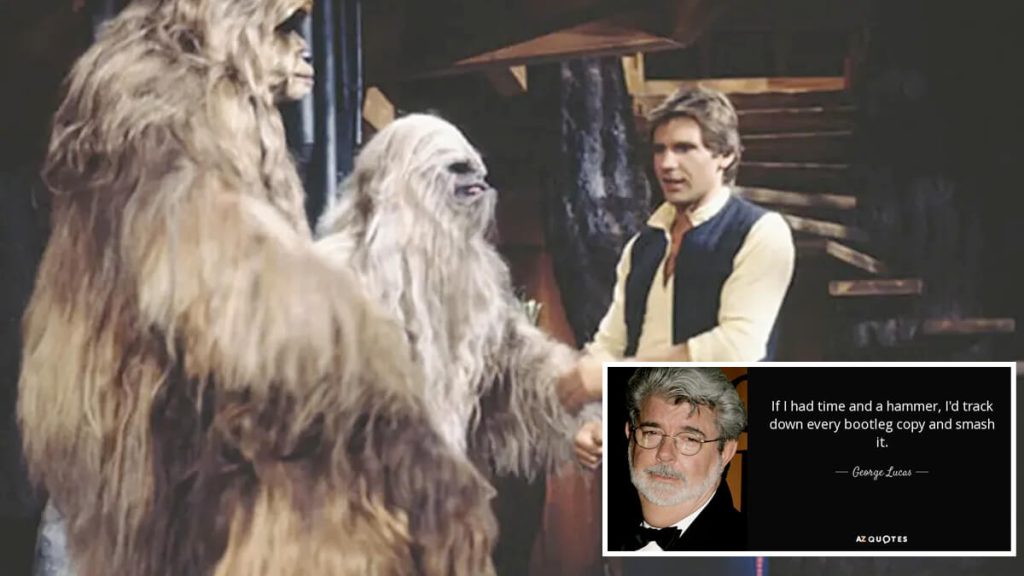
Harrison Ford Comes to Rescue “Indiana Jones”
Anyway … It’s now literally just weeks before production of “Raiders of the Lost Ark” is supposed to begin and Spielberg & Lucas have just learned that that they’ve lost their film’s star. CBS is flat-out refusing to release Tom Selleck early from his “Magnum PI” contractual obligation. So Steven & George now have to find someone else to play Indy … and fast.
The real irony here is … The American Federation of Television and Radio Artists would go on strike in the Summer of 1980. Which then shut prematurely shut down production of the first season of “Magnum PI.” (As a direct result, the first full season of this action drama to air on CBS only had 18 episodes, rather than the usual 22). And because this job action lasted ‘til October 23rd of that same year … Well, this meant that Tom Selleck would have actually been free to start shooting “Raiders of the Lost Ark” on June 23, 1980 because production of Season One of “Magnum PI” was already shut down by then due to that AFTRA strike.
But no one knew – in May of 1980, anyway – that this job action was going to happen in just a few weeks. All that Steven Spielberg & George Lucas knew was that they now needed a new lead actor for “Raiders.” And circling back on Jeff Bridges was no longer an option. As I mentioned earlier, Jeff had agreed to do “TRON” for Disney. And – in the interim – Bridges gone off to shoot “Cutter’s Way” for MGM / UA.
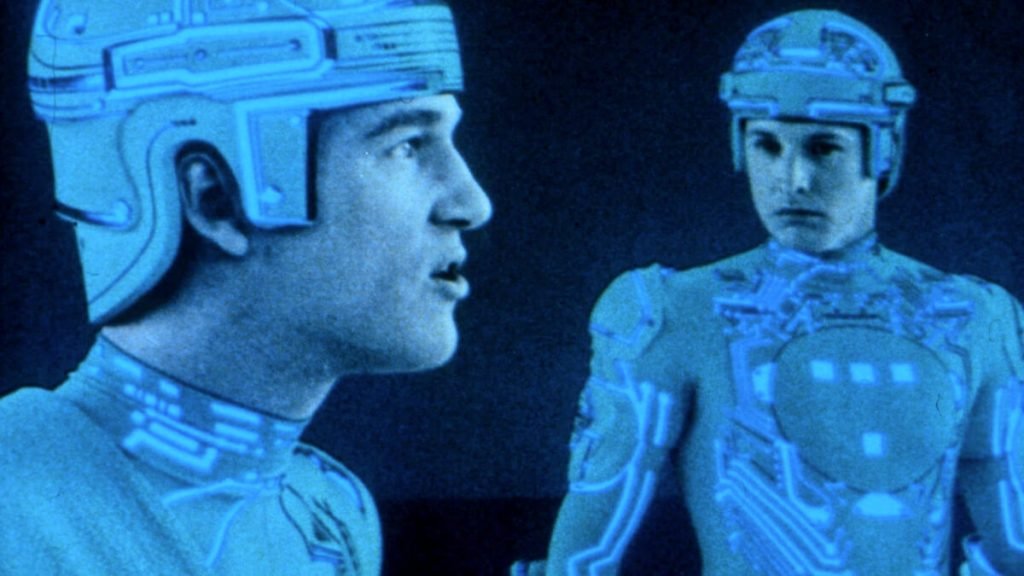
So this is where Harrison Ford enters the equation. As he recalls:
In May of 1980, I get a call from George Lucas. Who says ‘I’m messaging a script over to you this morning. As soon as it gets there, I need you to immediately read this script. Then – as soon as you’re done – I need you to call.
So the script arrives and it’s for ‘Raiders.’ I read it and it’s good. So I call George back and say ‘It’s good.’ And he then says ‘Would you be interested in playing Indy?’ I say that it looks like it would be a fun part to play.
George then says ‘ That’s great to hear. Because we start shooting in four weeks. Now I need you to meet with Steven Spielberg today and convince him that you’re the right guy to play Indy.’
Of course, given that Spielberg had been pushing for Ford to pay Indy ever since he had first seen that work-in-progress version of “The Empire Strikes Back” … Well, Harrison’s meeting with Steven was very, very short. And just a few weeks later, Spielberg, Lucas & Ford were all at the Port de la Pallice in La Rochelle. Where – on the very first day of shooting on “Raiders” (which – again – was June 23, 1980)– the scene that was shot was the one where that Nazi sub (the one that Indy had lashed himself to its periscope by using his bullwhip as a rope) was arriving at its secret base.
And all of this happened because Harrison immediately agreed to do “Raiders of the Lost Ark” when the part of Indy was first offered to him in mid-May of 1980.
Before “Star Wars” was “Star Wars”
So why such a quick yes? Well, you have to remember that “Empire Strikes Back” wouldn’t be released to theaters ‘til May 21, 1980. And no one knew at that time whether this sequel to the original “Star Wars” would do as well at the box office as “A New Hope” had back in 1977 (FYI: “Empire” would eventually sell over $500 million worth of tickets worldwide. Which is roughly two thirds of what the original “Star Wars” earned three years earlier).
More to the point, the four films that Harrison had shot right after “A New Hope” / prior to “Empire Strikes Back” (i.e., “Heroes” AND “Force 10 from Navarone” AND “Hanover Street” AND “The Frisco Kid”) had all under-performed at the box office. So to Ford’s way of thinking, taking on a role that Tom Selleck was no longer available to play – one that had the potential of spawning two sequels – seemed like a very smart thing to do. Especially after three years of cinematic stumbles.
By the way, whenever this topic ever comes up, Harrison Ford is very gracious. He always makes a point of saying that he’s grateful to have gotten this career opportunity. More to the point, that he still feels kind of bad that Tom Selleck never got the chance to play this part.
Tom Selleck After “Indiana Jones”
That said, we shouldn’t feel too bad for Tom Selleck. After all, the original “Magnum PI” proved to be a long running hit for CBS. And in an effort to smooth over any residual bad feelings that may have resulted from Tom being forced to give up “Raiders” back in May of 1980, Selleck was eventually allowed to create his own production company (i.e., T.W.S. Productions, Inc. As in Thomas William Selleck Productions). Which – after the fact – was then cut in on some of those “Magnum PI” -related revenue streams.
More to the point, while “Magnum PI” was on hiatus following its second year in production, Selleck flew off to Yugoslavia. Where he then shot his own Indiana Jones-esque film for theatrical release. Which was called “High Road to China” in the States, but – overseas – was promoted as “Raiders of the End of the World.”
FYI: Warner Bros. released “High Road to China” stateside 40 years ago this year. On March 18, 1983, to be exact. It didn’t do all that great at the box office. $28 million in ticket sales versus $15 million in production costs.
And over the years, there’s even been some talk of finding a way to maybe set things right here. By that I mean: Finally finding a way to officially fold Tom Selleck into the world of Indiana Jones.
Could Tom Selleck Work with Indiana Jones?
The way I hear it, between the time when “Indiana Jones and the Last Crusade” was theatrically released in May of 1989 and when “Indiana Jones and the Kingdom of the Crystal Skull” debuted in May of 2008, there were a number of ideas for Indiana Jones sequels tossed around. And from what I’ve been told, there was at least one treatment for a fourth Indiana Jones film written that proposed pairing up Harrison Ford & Tom Selleck. With the idea here being that Selleck was supposed to have played Ford’s brother.
Obviously that film was never made. And – no – I don’t know what state Indiana Jones’ brother was supposed to be named after.
This article is based on research for Looking at Lucasfilm “Episode 80”, published on June 29, 2023. Looking at Lucasfilm is part of the Jim Hill Media Podcast Network.
Television & Shows
Who Wants to Film a Game Show? – History of Game Shows at Disney Theme Parks
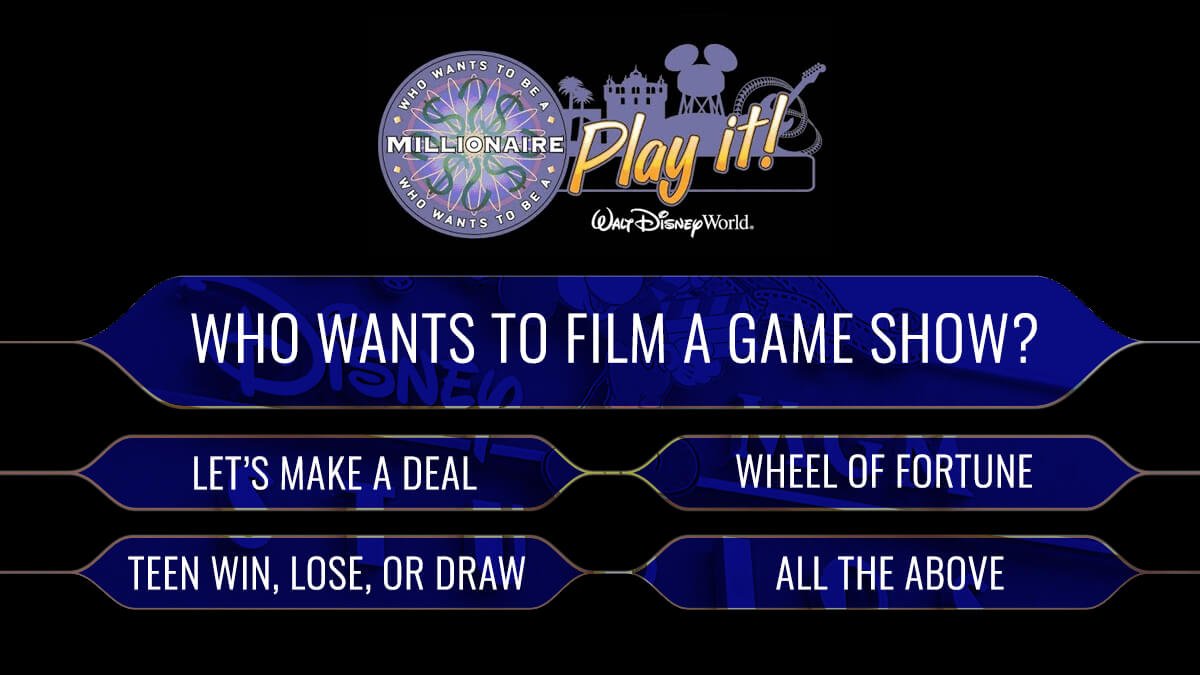
On April 10, 2001, a fleet of armored cars rolled through the streets of Disney’s Hollywood Studios. And no, they weren’t hauling away all of those $35 Lightning Lane fees that WDW visitors had been charged during Easter Week (That’s surge pricing gone crazy). But – rather – those armored cars were delivering Regis Philbin & Mickey Mouse to the site of that theme park’s newest attraction, “Who Wants to Be a Millionaire – Play It!”
“Who Wants to Be a Millionaire” – ABC Television Game Show
This was the Imagineers attempting to capitalize on a worldwide phenomenon. This hugely popular television game show had originally been launched just three years earlier in the UK. By 1999, ABC had acquired the US broadcast rights to “Who Wants to Be a Millionaire.” In mid-August of that year, as sort of a trial balloon, that broadcast network did a two week-long run of this game show in primetime with Philbin (Who – as that time – was co-host of Buena Vista Television’s syndicated daytime talk show, “Live with Regis & Kelly”) as host.
“Who Wants to Be a Millionaire” scored so high in the ratings that ABC brought it to primetime just three months later. And this game show did so well ratings-wise during the crucial November 1999 Sweeps period, that – starting in 2000 – this Disney-owned television network began airing episodes of “Millionaire” sometimes three, four and even five nights a week. Where as many as 28 million viewers would then tune in to say Regis say “Is that your final answer?”
And given that this is The Walt Disney Company were talking about here (which – when it has a hit on television [Think Davy Crockett, Zorro, even Baby Grogu on “The Mandalorian”] – immediately looks for other ways to cash in on this phenomenon. Strike while the iron is hot. Haul in all those Benjamins before this fad inevitably fads), the question almost immediately came up: What can we do with “Millionaire” at the Disney Parks? Is there any way we can turn this hit game show into something that the Guests can do at – say – Disney’s Hollywood Studios and/or Disney California Adventure.
Game Shows at Disney-MGM Studios
And the Imagineers said “Sure. We’ll just do what we did with ‘Let’s Make a Deal’ at the Studios back in 1990.”
Do you remember the “Let’s Make a Deal” attraction that used to be presented several times daily in Soundstage One at what was then called Disney-MGM Studios theme park back in the early 1990s? This was back when Walt Disney World’s third gate was supposed to be a working studio. A place where Guests could then see actual movies & TV shows being made as they walked through those sound-proof, glassed-corridors. Which had been built into those three soundstages that Florida tourists got to visit whenever they took Disney-MGM’s backstage tour.
This theme park opened in May of 1989. And almost immediately, Disney found that it was far harder to persuade film & television professionals to fly on down to Florida and then shoot their movies & TV shows on site at the Disney-MGM theme park than they thought it would be. And given that the Disney Channel couldn’t really afford to film its entire broadcast line-up in Orlando (Over the years, only a handful of that cable channel’s series – “MMC – The New Mickey Mouse Club,” “Adventures in Wonderland,” and “Storytime with Belle” – were actually shot at Disney-MGM) … As 1989 gave way to 1990, the executives who were in charge of Disney World’s third theme park really began to scramble. Looking for some movie or TV show that was willing to be produced inside of Disney’s brand-new, very-expensive-to-build soundstages in Central Florida.
“Wheel of Fortune” Filmed at Disney-MGM Studios
Mind you, by now, the syndicated version of “Wheel of Fortune” – hosted by Pat Sajak & Vanna White…
FYI: Those two have been working together on this TV game show since 1981. Sajak [Who – starting with the 2023 – 2024 season of “Wheel of Fortune” – has been the host of this game show for 41 years. Vanna, on the other hand, has been turning letters on this program since 1975. That’s 46 years if you can believe it …
Anyway, “Wheel of Fortune” had – the year previous – shot 10 episodes onsite at Disney-MGM. And that TV game show already had plans to return to Orlando in 1990 and shoot another set of shows. Guests seemed to have really enjoyed getting the chance to sit in on a taping of “Wheel of Fortune.” Which is what then made Disney-MGM officials think: “Okay. Let’s see if there’s another TV game show that might then be willing to be produced in our Florida soundstages.”
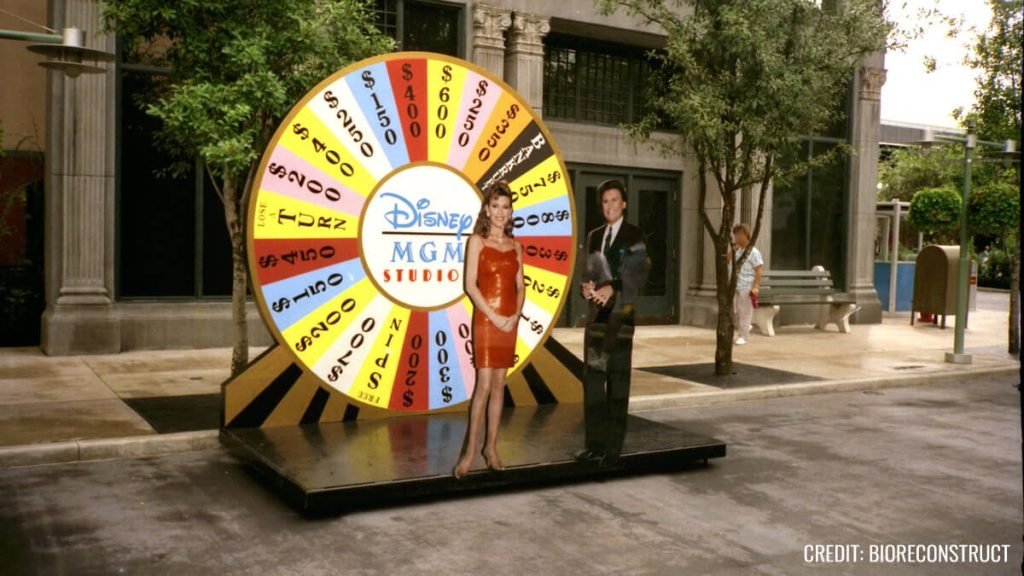
“Let’s Make a Deal” Filmed at Disney-MGM Studios
And – as it turns out – there was: “Let’s Make a Deal.” This classic TV game show had originally debuted on NBC back in December of 1963 as part of that network’s weekday morning line-up. After 5 years on the Peacock network, “Let’s Make a Deal” suddenly jumped to ABC in 1968. Where it then ran as part of the Alphabet network’s weekday morning line-up for another 8 years.
Hosted by Monty Hall (who served as master of ceremonies on 4500 half-hour-long episodes of this TV game show back in the 1960s & 1970s), “Let’s Make a Deal” had been so popular with TV viewers / had such strong brand recognition that – by 1989 – there had already been two attempts to revive the program. One in 1981 and a second attempt in 1984.
By January of 1990, a third attempt to revive “Let’s Make a Deal.” Only this time around, Monty Hall wasn’t going to be in front of the camera. He was only going to be a producer of this TV game show.
“I’m looking for new fields to conquer,” Hall said in an interview with the Los Angeles Times at the time. “I am committed to finding just the right new host for the show.”
Disney learned about this revival of “Let’s Make a Deal” that was in the works and quickly approached Hall & Co. By February of 1990, a deal had been struck. This TV game show would begin shooting in Florida in June of that same year and typically shoot two shows a day several times a week.
Faux Shows of “Let’s Make a Deal” at Disney-MGM Studios
Which brings us to what Disney-MGM would do on those days when this 1990 revival of “Let’s Make a Deal” wasn’t shooting. Which was that it would load Guests into Soundstage One anyway (sometimes five and six times a day) and do a pretend taping of “Let’s Make a Deal.” Guests would be pulled out of line outside of the soundstage and then taken into the soundstage ahead of this pretend taping. Where – just like game participants did during production of the original version of “Let’s Make a Deal” game show back in the 1960s & 1970s – Guests would be encouraged to dress in zany outfits. Only these zany outfits would then be pulled from Disney World’s Wardrobe Department. Which had over 15,000 costume pieces right there onsite at Disney-MGM (You used to be able to see a lot of these costumes on display when you took Disney-MGM’s tram tour).
Disney spared no expense on this project. They built an elaborate two level set for this “Let’s Make a Deal” revival inside of Soundstage One. They also installed seating for 800 Guests inside of that soundstage (So that 1600 people could then see a taping of this game show on those days when “Let’s Make a Deal” was actually taping. Shooting two episodes back-to-back. And also because upwards of 4000 Guests could then get in on a faux taping of “Let’s Make a Deal” on those days when production of this TV game show was dark and Disney-MGM was just pretending to shot an episode of “Let’s Make Deal’).

Did the Revived “Let’s Make a Deal” Work?
It was a great idea on paper. The new version of “Let’s Make a Deal” began shooting at Disney-MGM in June 4, 1990. These episodes actually began airing on NBC some 5 weeks later on July 9th of that same year. And that’s when the trouble started. Monty Hall had selected as host of this “Let’s Make a Deal” revival a young guy called Bob Hilton. Who was handsome & affable but just not up the task of handling a TV game show. Especially one that had a live audience of 800 people.
In hindsight, Disney’s desire to turn this “Let’s Make a Deal” revival into an actual attraction at Disney-MGM tanked the TV show. The original version of this television series on NBC & ABC in the 1960s & 1970s had an audience of only 200 people tops. It also had a simple, single level set of just … Well, Door Number One, Door Number Two and Door Number Three. Plus whatever was in the box that Jay was bringing down the aisle.
Whereas the version of the “Let’s Make a Deal” set than was built on Soundstage One had two levels. Plus the Disney characters regularly took part in the tapings of this TV game show. Bob Hilton – as a TV newbie – just couldn’t compete. He was swamped by his surroundings.
Quickly realizing that Hilton was in over his head, Monty Hall (who – let’s remember – was one of the producers of this “Let’s Make a Deal” revival) saw that the ratings for this TV game show were tanking and made a tough decision. Which was to fire Bob Hilton and then step in as the new host of this “Let’s Make a Deal” revival.
It didn’t help. By January of 1991 (just six months after this show had first debuted), NBC had pulled this “Let’s Make a Deal” revival off of its weekly daytime morning line-up and then replaced with a reality show which featured footage from trials around the country. Which left Disney with a dark soundstage and a really expensive set that now needed to be torn down & hauled away.
“Who Wants to Be a Millionaire – Play It!”
Back now to “Who Wants to Be a Millionaire – Play It!” (which first opened to the theme parking-going public on April 7, 2001), the Imagineers definitely took the hard lessons they learned from that “Let’s Make a Deal” revival and then applied those when it came to turning this hit ABC primetime series into a theme park attraction.
First of all, WDI made sure that what they were building inside of Soundstage Two & Three was virtually identical to what people had seen when they were watching “Who Wants to Be a Millionaire” at home. The set, the lighting cues, the sound effects, the musical stings were all replicated to the best of the Imagineers’ abilities.
How Guests Played “Who Wants to Be a Millionaire – Play It!”
The one thing that was different was … Well, the Guests taking part in “Who Wants to Be a Millionaire – Play It!” weren’t playing for money. But – rather – points.
And for each question they got right, the Guests were then awarded a certain number of points (and a collectible pin that then acknowledged that this person then acknowledged that they got to that particular level while taking part in “Who Wants to Be a Millionaire – Play It!”). And if this Guest then made it through the first few levels, they then:
- At the 1,000-point level, they then earned a “Who Wants to Be a Millionaire – Play It!” baseball cap.
- At the 32,000-point level, they earned a “Who Wants to Be a Millionaire – Play It!” polo shirt.
(In the early days of this attractions, contestants were also awarded a copy of the “Who Wants to Be a Millionaire” CD-ROM game after they correctly answered the 32,000-point question).
- At the 1,000,000-point level, they were then awarded an “I’m a Million Point Winner” black leather jacket. These Guests were also gifted a trip to New York City to see a taping of the real “Who Wants to Be a Millionaire” TV show.
FYI: The folks at Disney-MGM sometimes changed this up. And – instead of that trip to NYC to attend a “Who Wants to Be a Millionaire” taping – they’d then gift these Guests a three night trip aboard the Disney Cruise Line.
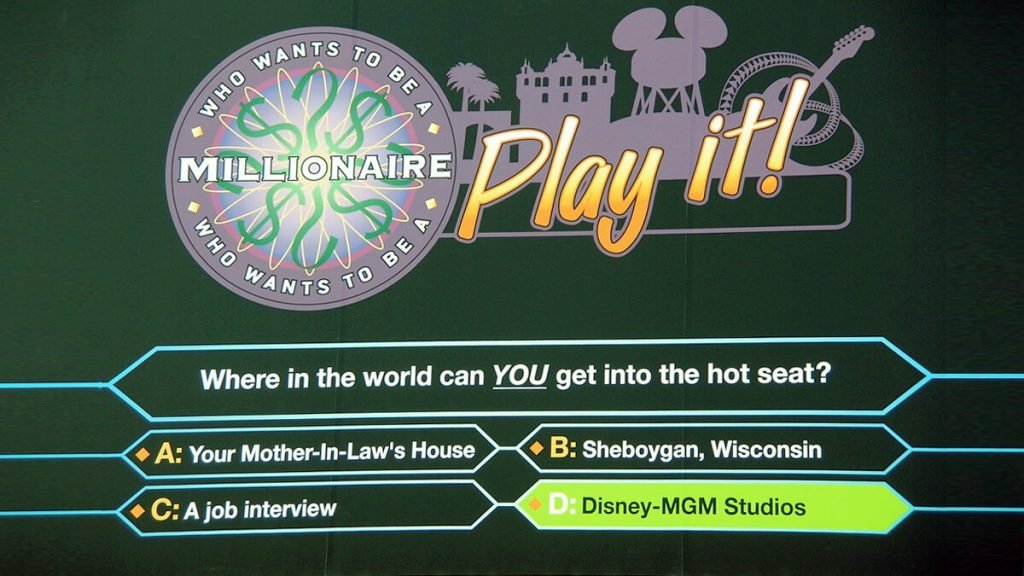
“Who Wants to Be a Millionaire – Play It!” at Disney California Adventure Park
“Who Wants to Be a Millionaire – Play It!” was popular enough with Disney-MGM visitors that a second version of this attraction was then fast-tracked for Disney California Adventure Park. A brand-new building – Soundstage 17 – was hurried thrown together in that Hollywood Studios Backlot section of that theme park over the Summer of 2001. With the West Coast version of this TV game show opening on September 14th of that same year. Just three days after 911.
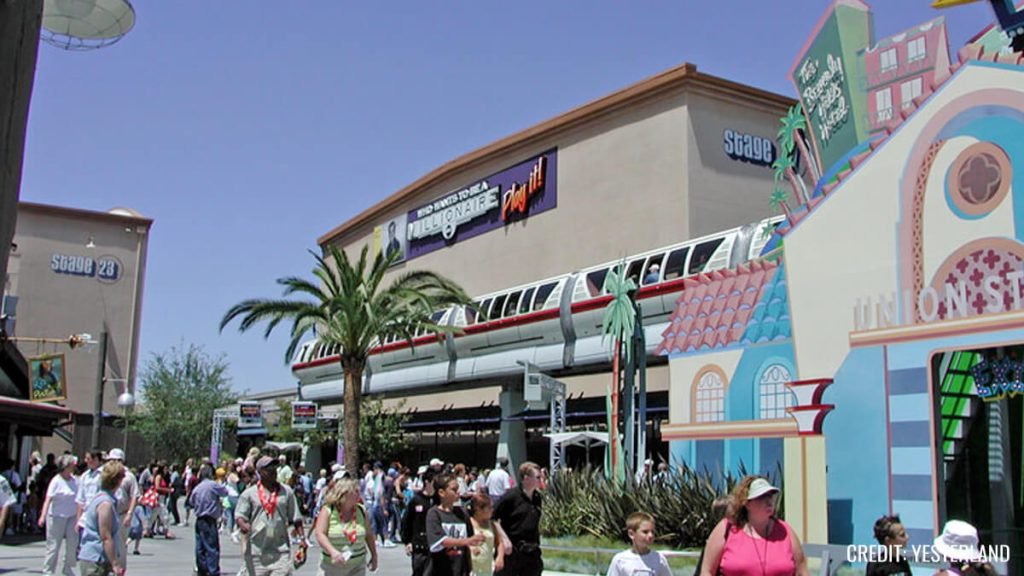
“Who Wants to Be a Millionaire” Pulled from Network TV
Wait. It gets worse. By this point, ABC had effectively killed the golden goose. The “Who Wants to Be a Millionaire” TV show was airing so often on the Alphabet Network now that audiences had started to lose interest in this. And by late June of 2002, ABC execs had pulled “Who Wants to Be a Millionaire” off of that network’s primetime schedule entirely.
Mind you, there was still the syndicated version of “Who Wants to Be a Millionaire” (which was hosted by Meredith Viera rather than Regis Philbin). Which would begin airing on television stations around the country in September of 2002. But “Who Wants to Be a Millionaire” was no longer the white-hot phenomenon that it once was. And the drooping attendance levels at the East & West Coast versions of “Who Wants To Be A Millionaire – Play It!” reflected that.
Removal from the Theme Parks
By August 20, 2004, Disney California Adventure threw in the towel. They shuttered their version of “Who Wants to Be a Millionaire – Play It!” on that day. And since that time, Soundstage 17 has been a variety of things. Among them “Olaf’s Snow Fest” and – more recently – it’s been the “Super Store featuring Avengers Campus.” Meaning that Soundstage 17 is the place you go to buy MCU stuff when the lines are too long inside of the Avengers Campus.
In Florida, “Who Wants to Be a Millionaire – Play It” hung on two years longer. It eventually shuttered on August 19, 2006 so that Soundstages Two & Three could then become home to “Toy Story Mania.” Which opened at Disney’s Hollywood Studios some 21 months later on May 31, 2008.
Fun Little Fact about “Who Wants to Be a Millionaire – Play It!” The TV version of this game show had a “Phone a Friend” option. The theme park version of this game show had a “Phone a Complete Stranger.” Which meant that a Cast Member standing outside of this soundstage would then attempt to recruit someone who just happened to be walking by this attraction at the moment this phone rang to come attempt to answer that question.
Memories of Game Shows in Disney Parks
Me personally, my favorite version of “Who Wants to Be a Millionaire – Play It!” was staged during “Star Wars Weekends” at Disney’s Hollywood Studios. This was when “Phone a Complete Stranger” was replaced by “Ask the Jedi Council.”
Any winners reading today? If so, do you still have your “Who Wants to Be a Millionaire – Play It!” baseball hat, polo shirt or leather jacket?
We would love to hear your stories. Let us know your memories of game shows in the parks in the comments or over on social media.
This article is based on research for The Disney Dish Podcast “Episode 422”, published on April 3, 2023. The Disney Dish Podcast is part of the Jim Hill Media Podcast Network.
Film & Movies
“Seinfeld” Moms: A Tribute to Two TV Moms We Lost in April 2022, Estelle Harris & Liz Sheridan
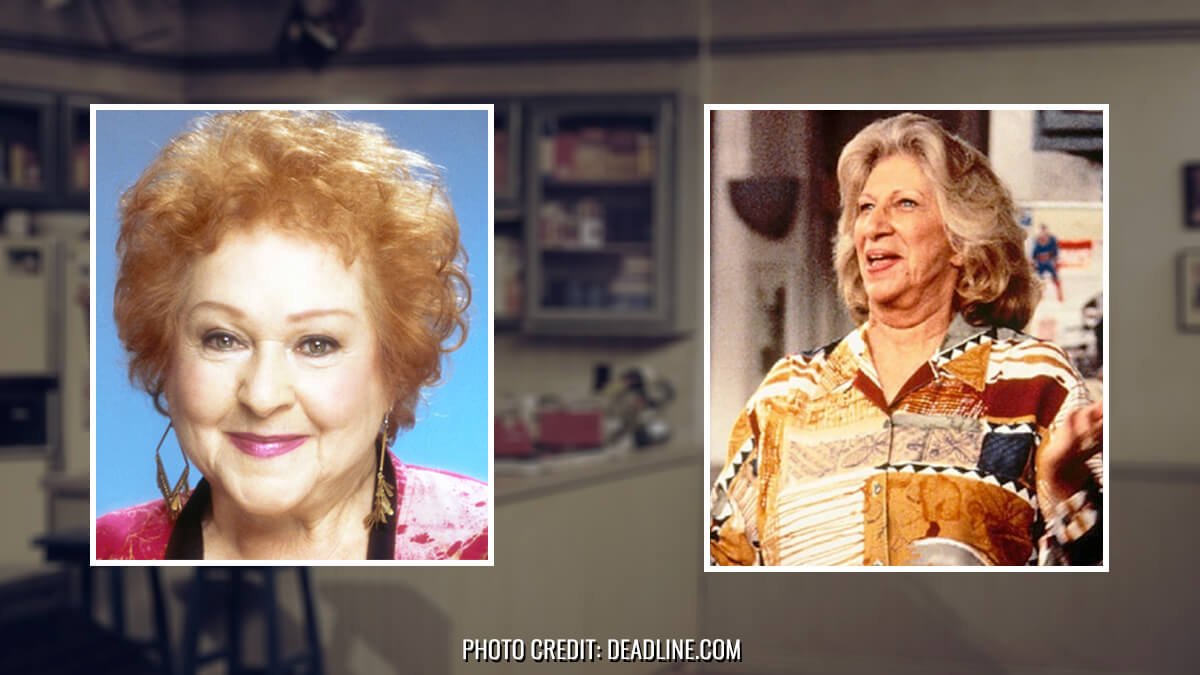
In what many have called his greatest poem, “The Waste Land” (Poetry fans will be celebrating the centennial of its publication later this year. It first appeared in print back in December of 1922. Anyway … ), T.S. Eliot once said “ … April is the cruelest month.”
Well, this past April was certainly cruel to “Seinfeld” fans. That’s when we not only lost Estelle Harris (Who played George Costanza’s Mom. Who was also named Estelle) but also Liz Sheridan (Who played the mother of that hit TV show’s title character, Helen Seinfeld).
Less than two weeks separated these performers’ passings. We lost Ms. Harris on Saturday, April 2nd and then Ms. Sheridan on Friday, April 15th. In a kind of interesting coincidence, both women died of natural causes at the age of 93.
Mind you, these two talented ladies took two very different paths when they started their careers in show business. Liz started early and began dancing on Broadway back in the 1950s.
In fact, if you’d like a look back at that time in Ms. Sheridan’s career, you should pick up a copy of “Dizzy and Jimmy,” the book she wrote back in 2000. It details her love affair with a certain 21-year-old Indiana farm boy who had traveled to NYC by way of Hollywood seeking his fortune. Maybe you’ve heard of this guy? Screen legend James Dean?
Whereas Estelle … Well, strange as this may seem (given how effortlessly she stole scenes from every other actor she ever worked with), Harris actually waited ‘til she turned 53 before then embarking on her professional performing career.
Estelle Harris & Liz Sheridan: Early Career in Television & Film
Estelle’s first film role was in Sergio Leone’s “Once Upon a Time in America” (1984). Harris’ first role of television quickly followed. She played Easy Mary, an elderly hooker on an episode of NBC’s “Night Court” back in 1985. And Harris’ performance got such big laughs at that night’s taping that the show’s producers quickly decided to write Estelle’s character into additional episodes.
A similar sort of thing happened around this same time in Liz Sheridan’s career. In 1986, she was hired to play the nosy neighbor on an episode of another NBC sitcom, “ALF.” But Sheridan’s performance as grumpy Raquel Ochmonek made such a big impression on the audience attending that evening’s taping the producers brought her back multiple times. Over the course of “ALF” ‘s four season run on NBC (September of 1986 – March of 1990), Liz appeared in nearly 30 episodes.
So it stands to reason that — when production of “The Seinfeld Chronicles” was getting underway in 1989 (This show’s name wouldn’t officially be shortened to just “Seinfeld” until the start of Season 2 in January of 1991) — whenever the question of “Who’s gonna play George or Jerry’s Mom?” would come up, the show’s creative team would always say it’s gotta be someone solid and strong. Some veteran performer who just can walk in and then immediately claim that role. In short, someone like Estelle Harris or Liz Sheridan.
Roles on “Seinfeld”
Sheridan made her very first appearance as Jerry’s Mom Helen relatively early on. We’re talking Episode 2 of Season One in an episode entitled “The Stake Out.” Which initially aired on NBC on May 31, 1990.
Whereas Georga Costanza’s Mom, Estelle … That character didn’t make her first appearance on “Seinfeld” until November of 1992. But give that Estelle Harris’ entrance into this by-then-hit sitcom came with “The Contest,” that infamous episode which introduced the phrase “Master of Your Domain” into the pop lexicon, few people ever forgot her arrival on that show.
Anywho … Being cast as George Costanza’s Mom really put Estelle Harris on the map. At least as far as animation studios were concerned.
Work in Animation
Estelle was soon hired to voice Mrs. Potato Head in “Toy Story 2” (1999). Which was truly inspiring casting when it came to the wife of Don Rickles’ Mr. Potato Head character. For her shrillness was a perfect counterpoint to Don’s vocal bombastics. She reprised this role twice more, “Toy Story 3” (2010) and “Toy Story 4” (2019). And that vocal performance wound up being Harris’ very last ever film role.
Just so you know: Liz Sheridan did some voice work for animation as well. She was the voice of Mrs. Stillman on “Life with Louie,” that animated sitcom from the 1990s built around the late, great Louie Anderson’s stand-up routine.
Back to Estelle Harris now … Since animators just loved her voice, Estelle wound up playing a lot of cartoon Moms over the past 25 years:
- Professor Hubert J. Farnsworth’s Mom on “Futurama”
- Sylvester’s Mom on “The Looney Tunes Show”
- even Death’s Mom on “Family Guy”
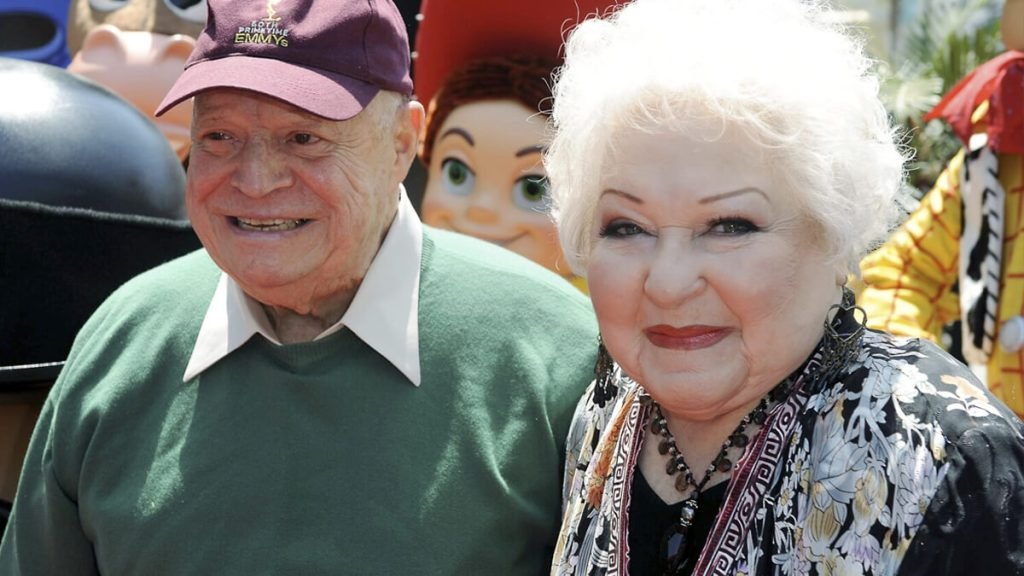
Conversation with Estelle Harris
And while I never got to meet Ms. Sheridan, I did once get the chance to sit down with Ms. Harris and then interview her in regards to Estelle’s reoccurring role on that Disney Channel hit from the mid-2000s, “The Suite Life with Zack & Cody.”
And I can tell you folks that — after having had a half hour-long conversation with this delightful woman — that that shrill, grating voice was Harris’ real voice. But the lady herself could not have been nicer. Estelle was a sweet old broad who was actually in on the joke. She just loved the fact that people were constantly hiring her to come on their shows & then be incredibly annoying.
Back to Estelle’s passing now … Last month, Harris’ really-for-real son Glenn — issued this statement:
“It is with the greatest remorse and sadness to announce that Estelle Harris has passed on this evening at 6:25 pm. Her kindness, passion, sensitivity, humor, empathy and love were practically unrivaled, and she will be terribly missed by all those who knew her.”
Then Estelle’s TV son, the hugely talented Jason Alexander, Tweeted out a tribute to this beloved performer:
“One of my favorite people has passed. My TV mama, Estelle Harris. The joy of playing with her and relishing her glorious laughter was a treat. I adore you, Estelle. Love to your family. Serenity now and always. RIP Estelle Harris.”
Jerry Seinfeld also used social media to share his thoughts about the sad passing of Liz Sheridan:
“Liz was always the sweetest, nicest TV mom a son could wish for. Every time she came on our show it was the coziest feeling for me. So lucky to have known her.”
More “Seinfeld” Dads and Relatives
And just in case, you’re wondering:
- We lost John Randolph (he was the actor who originated the role of George Costanza’s Dad) back in 2004
- We lost Barney Martin (he played Jerry’s Dad) back in 2005
- We lost Len Lesser (he played Jerry’s Uncle Leo) in 2011
- And we lost Jerry Stiller (who took over the role of George Costanza’s Dad from John Randolph and really made it his own) in 2020
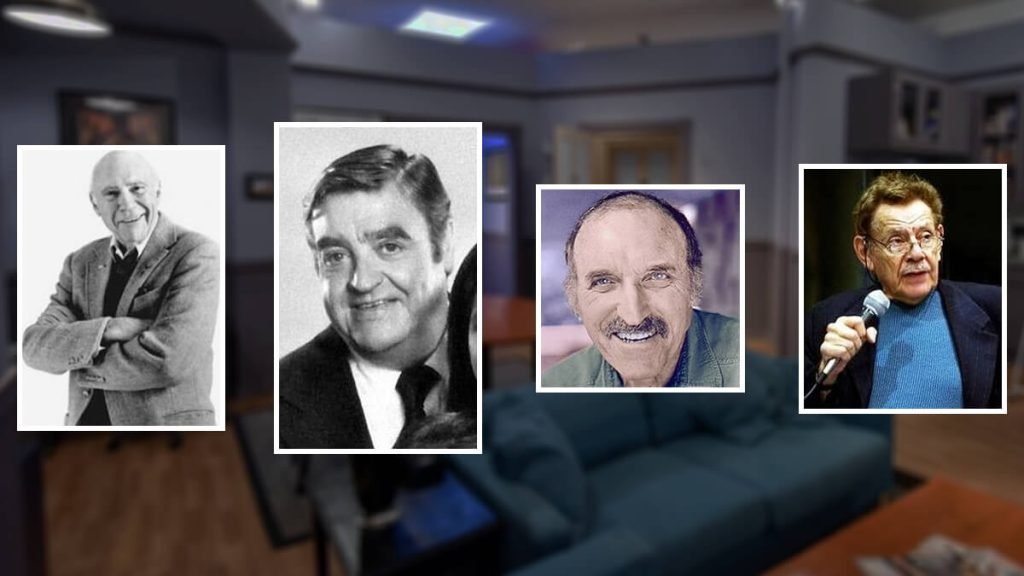
Mom – Let Her Know How You Feel
Okay. I know. These were just two very talented ladies who played Moms on TV. But let this be a reminder to you that — in this life — you only get one Mom. My own turned 90 earlier this year. So — if you get the chance today — be sure and let them know how you really feel about them.
Unless — of course — you have a somewhat problematic relationship with your Mother. If so … Well, then maybe you should wait ‘til Festivus to let Mom know about how you really feel about her. Just remember that you’re not allowed to air any grievances until you’re actually holding that unadorned aluminum pole.
Happy Mothers Day!
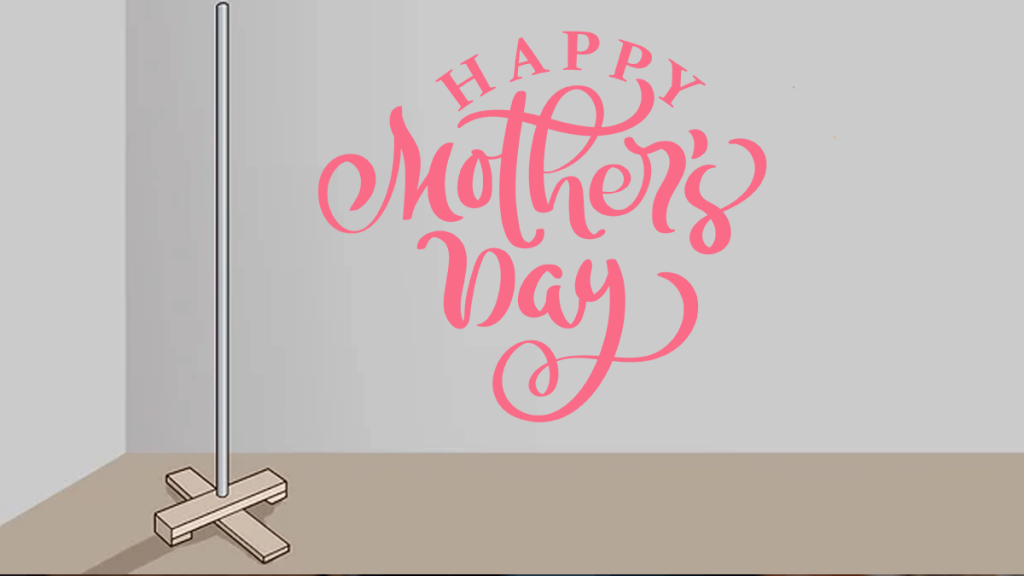
-

 History10 months ago
History10 months agoThe Evolution and History of Mickey’s ToonTown
-

 History11 months ago
History11 months agoUnpacking the History of the Pixar Place Hotel
-

 History11 months ago
History11 months agoFrom Birthday Wishes to Toontown Dreams: How Toontown Came to Be
-

 Film & Movies8 months ago
Film & Movies8 months agoHow Disney’s “Bambi” led to the creation of Smokey Bear
-

 News & Press Releases10 months ago
News & Press Releases10 months agoNew Updates and Exclusive Content from Jim Hill Media: Disney, Universal, and More
-

 Merchandise8 months ago
Merchandise8 months agoIntroducing “I Want That Too” – The Ultimate Disney Merchandise Podcast
-

 Theme Parks & Themed Entertainment3 months ago
Theme Parks & Themed Entertainment3 months agoDisney’s Forgotten Halloween Event: The Original Little Monsters on Main Street
-

 Film & Movies3 months ago
Film & Movies3 months agoHow “An American Tail” Led to Disney’s “Hocus Pocus”








